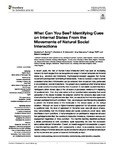What Can You See? Identifying Cues on Internal States From the Movements of Natural Social Interactions
| dc.contributor.author | Bartlett, ME | |
| dc.contributor.author | Edmunds, CER | |
| dc.contributor.author | Belpaeme, Tony | |
| dc.contributor.author | Thill, Serge | |
| dc.contributor.author | Lemaignan, Séverin | |
| dc.date.accessioned | 2019-09-02T11:41:41Z | |
| dc.date.available | 2019-09-02T11:41:41Z | |
| dc.date.issued | 2019-06-26 | |
| dc.identifier.issn | 2296-9144 | |
| dc.identifier.issn | 2296-9144 | |
| dc.identifier.uri | http://hdl.handle.net/10026.1/14853 | |
| dc.description.abstract |
In recent years, the field of Human-Robot Interaction (HRI) has seen an increasing demand for technologies that can recognize and adapt to human behaviors and internal states (e.g., emotions and intentions). Psychological research suggests that human movements are important for inferring internal states. There is, however, a need to better understand what kind of information can be extracted from movement data, particularly in unconstrained, natural interactions. The present study examines which internal states and social constructs humans identify from movement in naturalistic social interactions. Participants either viewed clips of the full scene or processed versions of it displaying 2D positional data. Then, they were asked to fill out questionnaires assessing their social perception of the viewed material. We analyzed whether the full scene clips were more informative than the 2D positional data clips. First, we calculated the inter-rater agreement between participants in both conditions. Then, we employed machine learning classifiers to predict the internal states of the individuals in the videos based on the ratings obtained. Although we found a higher inter-rater agreement for full scenes compared to positional data, the level of agreement in the latter case was still above chance, thus demonstrating that the internal states and social constructs under study were identifiable in both conditions. A factor analysis run on participants' responses showed that participants identified the constructs interaction imbalance, interaction valence and engagement regardless of video condition. The machine learning classifiers achieved a similar performance in both conditions, again supporting the idea that movement alone carries relevant information. Overall, our results suggest it is reasonable to expect a machine learning algorithm, and consequently a robot, to successfully decode and classify a range of internal states and social constructs using low-dimensional data (such as the movements and poses of observed individuals) as input. | |
| dc.format.extent | 49- | |
| dc.format.medium | Electronic-eCollection | |
| dc.language | eng | |
| dc.language.iso | en | |
| dc.publisher | Frontiers Media | |
| dc.relation.uri | https://freeplay-sandbox.github.io | |
| dc.relation.uri | https://github.com/severin-lemaignan/pinsoro-kinematics-study/blob/master/analysis/analyses_notebook.ipynb. | |
| dc.relation.uri | https://github.com/severin-lemaignan/pinsoro-kinematics-study/ | |
| dc.subject | human-robot interaction | |
| dc.subject | machine learning | |
| dc.subject | recognition | |
| dc.subject | social interaction | |
| dc.subject | social psychology | |
| dc.title | What Can You See? Identifying Cues on Internal States From the Movements of Natural Social Interactions | |
| dc.type | journal-article | |
| dc.type | Journal Article | |
| plymouth.author-url | https://www.ncbi.nlm.nih.gov/pubmed/33501065 | |
| plymouth.issue | JUN | |
| plymouth.volume | 6 | |
| plymouth.publication-status | Published online | |
| plymouth.journal | Frontiers in Robotics and AI | |
| dc.identifier.doi | 10.3389/frobt.2019.00049 | |
| plymouth.organisational-group | /Plymouth | |
| plymouth.organisational-group | /Plymouth/Faculty of Health | |
| plymouth.organisational-group | /Plymouth/Faculty of Science and Engineering | |
| plymouth.organisational-group | /Plymouth/REF 2021 Researchers by UoA | |
| plymouth.organisational-group | /Plymouth/REF 2021 Researchers by UoA/UoA11 Computer Science and Informatics | |
| plymouth.organisational-group | /Plymouth/Research Groups | |
| plymouth.organisational-group | /Plymouth/Research Groups/Marine Institute | |
| plymouth.organisational-group | /Plymouth/Users by role | |
| dc.publisher.place | Switzerland | |
| dcterms.dateAccepted | 2019-06-06 | |
| dc.rights.embargodate | 2019-12-20 | |
| dc.identifier.eissn | 2296-9144 | |
| dc.rights.embargoperiod | Not known | |
| rioxxterms.version | Version of Record | |
| rioxxterms.versionofrecord | 10.3389/frobt.2019.00049 | |
| rioxxterms.licenseref.uri | http://www.rioxx.net/licenses/all-rights-reserved | |
| rioxxterms.licenseref.startdate | 2019-06-26 | |
| rioxxterms.type | Journal Article/Review |


